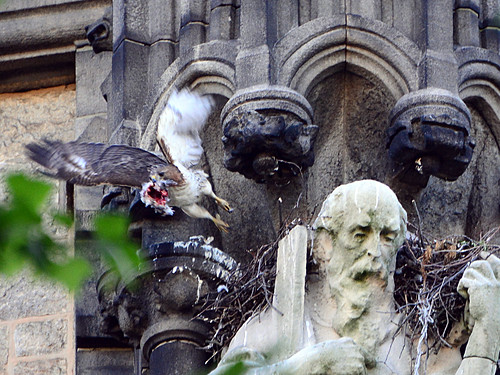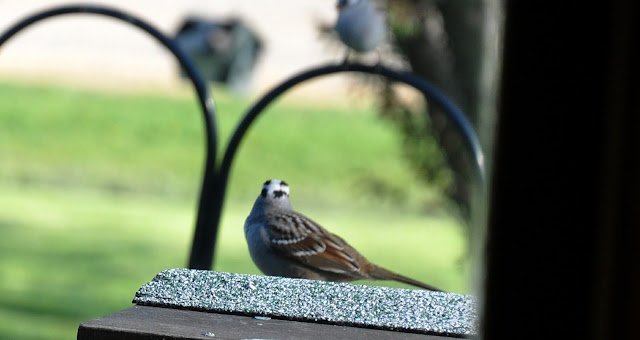photo courtesy of www. palemale.com
Octavia feeds the thriving three on the Fifth Avenue nest shortly after Pale Male delivered dinner.
Here we have the classic shape of a Red-tailed Hawk tree nest. And as it turned out there was a female up there and she was none too happy about the human company working on the prescribed burn not far away. She came screeching off the nest, did a few mid-level circles, and then went back to the nest, plumped down, and glared. Note there are no photos of her doing this as we were far too busy keeping the fire away from the nest area to take time out for photos.
The nest sitter's mate then appeared on the scene, not so much to yell at us but rather to perch in a tree and wait for any prey that might be flushed out of cover by the fire.
As I mentioned briefly before, at every burn I did there was at least one, I expect experienced Red-tail, who appeared on the scene the moment a fire was lighted or even before. No dummies, they know that a fire exposes prey and they're ready to take advantage of the circumstances.
Dale Dean of Landscape Restoration explains the next step of the burn plan.
This was a 140 acre wetland burn with a 4 million dollar house in the middle. One never wants to loose control of a fire but it was particularly crucial in this case to say the least. All went very well.
A week later things had really begun to get green but this nest in a very tall oak, oaks leaf out slightly later, is still visible from a distance.
Neither hawk seemed distressed by any of the proceedings. In fact as soon as the fire was lit, the male positioned himself in a handy tree poised for hunting.
Phragmites (Phragmites australis subsp. australis), right frame, is a dreadful invasive in U.S. wetlands. Not only is it vigorous but it exudes two toxins which destroy the seedlings of desirable native plants. It takes two to three burns to eradicate.
Last season on my first burn, I'd scared the pants off myself, when I'd lit this patch which was twice the height it is this season, and it went up in a huge wall of fire in seconds.
This year with the very wet Spring, which pushed many burns closer to the cutoff of May 15th, when things had already begun to green up, it was impossible to set it alight at all. It was very disappointing not to get a second crack at it and perhaps eradicate it from that area.
I found another Red-tailed nest a few days later. Can you see it.
Look carefully at the nest and it appears there is at least one eyass in it.
NEXT UP THE MYSTERY BIRD!
Obviously we have a Chipping Sparrow on the left, but what is the bird on the right? In sunlight the bird's blue is, or is similar to an Indigo Bunting.If this is an Indigo Bunting why isn't he blue all the way down?
The full strength indigo color is showing on a bit of his wing. Is he leucistic? Or upon thought, I'm betting he's a male Indigo Bunting who is molting.
AND NEXT...JUST BECAUSE I'VE NOT FOCUSED ON A THIS PARTICULA CHARACTERISTIC BEFORE..
Yes, a White-crowned Sparrow... But why is he called a White-crowned Sparrow. Why not a Striped Crown Sparrow for instance?
Because his "crown" actually is white, not striped.
From blog contributor Robin of Illinois....
The great osprey rescue
By Jackie Jadrnak / Journal North Reporter on Wed, May 15, 2013 SANTA FE – Badly tangled in fishing line, the female osprey dangled upside down – perhaps for a couple of days – while her mate fretted and called from their nest and the air above.
An outdoorsman getting ready for a canoe outing with friends down
the Rio Chama on Sunday happened to spot her and – talk about luck – he
and a friend on the trip happened to be wildlife biologists with an
expertise in raptors.
There’s no way they were going to leave her there.
Bob Murphy, on his day off from U.S. Fish and Wildlife Service in Albuquerque, cuts a fishing line that was tangled around a female osprey near Heron Lake in northern New Mexico. A group of people spotted and rescued her on Sunday, May 12, 2013. The opsrey is being treated at The Wildlife Center in Espanola.
“I thought she was dead,” said Dale Stahlecker, who has a business in Santa Fe. But then he saw her move.
Hustling back to the canoe put-in site, Stahlecker told his fellow canoeists they had to do a rescue.
“I thought maybe someone fell in the river,” said Bob Murphy, a
wildlife biologist with the U.S. Fish and Wildlife Service in
Albuquerque, who does a lot of raptor work in his free time.
Instead of launching canoes, the friends launched a four-hour
effort that brought together helpers ranging from an electric company
linesman to personnel at Heron Lake State Park, where the trapped osprey
was dangling about 60 feet up a Ponderosa pine.
“It really was a big group effort,” Murphy said. “People from completely different walks of life were coming together.”
The first issue was how the heck to get her down.
Stahlecker called some friends in the area, who in turn called around to other people they knew.
State park personnel brought a ladder, but it reached only halfway
to the first branches on the towering pine. A linesman with the local
electric utility offered a 50-foot expandable pole, thinking they could
use it to cut the fishing line holding the bird, while others gathered
tarps to catch her if she fell.
But the pole was about 10 feet too short.
And the area was too steep for a bucket truck.
It was time for Murphy to climb the tree.
In a telephone interview, you could almost hear him verbally shrug. “I’ve climbed a lot of trees to raptor nests,” he said.
The linesman provided Murphy with “pole irons,” a metal iron
strapped on the lower leg with a spike just beyond the heel that sticks
into the tree and helps support a climber. State park workers provided a
sturdy rope, and canoeists came up with carabiners, which combined to
provide a harness, along with safety and belaying lines that provided
security for Murphy’s ascent.
“If you fall, it’s only a foot or so,” he said of the system,
adding that it took only about 15 minutes up the tree and five minutes
down. “The worst thing is the ants crawling on the tree and biting your
arms.”
While the osprey was obviously disturbed by his presence and
started flapping, Murphy said he was able to grab her feet, pull her
close, use a knife to cut the monofilament that was coiled around her
feet and up to her shoulder and neck, then carefully place her into a
backpack for the trip back down.
“On one of her toes, there was a lot of scraping from the
monofilament, but the bottoms of her feet looked good. … Her eyes were
bright,” he said.
In the darkness of the backpack, “she never moved,” he added.
The rescuers took the osprey to The Wildlife Center in Española,
where “we think that she’s going to be OK,” development director Cheryl
Bell said with some caution Tuesday.
The ability to use their feet to snag fish for food is crucial for
ospreys, Stahlecker said. Without the ability to grip, this osprey
couldn’t be released back into the wild.
Bird improving
If all goes well, the bird will be released in a week, Bell said.
Circulation appears to be coming back to the toe that was most strangled
by the line, she said. The osprey also has neurological problems from
dangling upside down for so long. “She kind of shakes and does funny
gripping things with her foot,” Bell said.
“But she’s improving. We’re feeding her with a tube down her
throat. … She is getting amino acids and supplements and today bits of
salmon,” she said. The bird likely got dehydrated and malnourished by
not feeding for a couple of days, Bell said, noting that tube feeding is
needed because ospreys generally won’t eat fish they didn’t pull live
out of the water themselves.
This osprey was found Sunday, May 12, 2013, near Heron Lake hanging from a tree by her nest. She was incapacitated by fishing line tangled around her legs and sent to the Wildlife Center in Espanola for rehab. (Photo by Dale Stahlecker)
Ospreys, which typically weigh 3 to 4 pounds and have a wingspan of
63 inches, showed up at Heron Lake in 1989, Stahlecker said, likely as
spinoffs from a population that grew around Durango, Colo. Now, they
have at least 19 territories around that body of water, he said.
“They were really affected by DDT,” Murphy said of that pesticide.
“Their population crashed, but they made a tremendous recovery.”
This isn’t the first bird The Wildlife Center has seen tangled in fishing line, Bell said.
“We had one with the line wrapped so tightly around the leg, the
leg fell off,” she said. “Every time I walk around that lake, I’m
picking up fishing line.”
“We’ve got to get the message home to people that they can’t be
messy,” Stahlecker said, explaining that the bird saw fishing line as
good nest material, and it ended up “terribly tangled” around her.
While the Mother’s Day rescue may have saved the osprey’s life, it
may have ruined her chances to raise any young this year. Although
Murphy was unable to see if the nest in the Ponderosa pine held any
eggs, the biologists said her time off the nest would have killed any
embryos.
 Photo courtesy of http://morningsidehawks.blogspot.com/ Having fed the eyasses Isolde whips off the nest with a partial pigeon. Check out the adventures of Isolde and the New Guy (or is it Norman after all) on Rob's blog, http://morningsidehawks.blogspot.com/
HAPPY HAWKING!!!!
Donegal Browne
| ||
Friday, May 17, 2013
Red-tailed Hawk Nests and Prescribed Burns, Invasive Phragmites, the Mystery Bird, White-crowned Not White Striped? And the Great Osprey Rescue And Isolde at the Cathedral
Subscribe to:
Comments (Atom)











